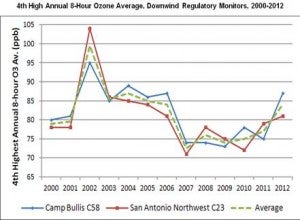Reducing Drilling Pollution—Wyoming Did It, No Big Deal. Will Texas?
 The technological advances that led to the “shale revolution” have undoubtedly had a large economic impact on the Texas economy – something state leaders and the oil and gas industry are never shy about pointing out. But the impact drilling has on air quality and public health, that’s something energy-friendly Texas has not been so quick to recognize.
The technological advances that led to the “shale revolution” have undoubtedly had a large economic impact on the Texas economy – something state leaders and the oil and gas industry are never shy about pointing out. But the impact drilling has on air quality and public health, that’s something energy-friendly Texas has not been so quick to recognize.
When not managed responsibly, drilling operations can contribute to the formation of ozone, also commonly known as smog. At certain concentrations, this pollution can trigger asthma attacks and cause other severe respiratory illnesses.
San Antonio is one place that’s seeing the clear connection between drilling and lower air quality, thanks to increased drilling just south of the city from the Eagle Ford Shale region. Before 2008, ozone levels in San Antonio had been steadily dropping, but when the shale revolution hit and drilling increased, regional ozone readings started going up. In fact, based on air quality monitor readings from the last three years, San Antonio’s air quality is the 2nd worst in the state. This correlation between drilling and ozone levels has been documented by The University of Texas and the Alamo Area Council of Governments, both of which concluded oil and gas activity in the Eagle Ford Shale is materially impacting ozone levels in San Antonio.
 And a federal appeals court today upheld EPA’s decision to include Wise County as part of the Dallas-Fort Worth region that has been designated as an area with unhealthy smog levels. The EPA specifically pointed to oil and gas drilling in Wise County as one of the reasons it had reached those levels.
And a federal appeals court today upheld EPA’s decision to include Wise County as part of the Dallas-Fort Worth region that has been designated as an area with unhealthy smog levels. The EPA specifically pointed to oil and gas drilling in Wise County as one of the reasons it had reached those levels.
This problem is not unique to Texas. In 2011, the smog in rural—but drilling-heavy—Pinedale, Wyoming, was worse than in Los Angeles. That got the attention of state leaders, who last year passed a rule requiring oil and gas companies in the state’s most polluted region to apply pollution controls on new oil and gas facilities. Last month, the state beefed up these rules even more, announcing it would extend them to existing sources of oil and gas pollution as well. These cost-effective pollution reduction strategies received support from not only conservation groups and local residents, but also industry. There is no reason to think others—including the energy giant, Texas, and its leading industry players—couldn’t do something similar to reduce ozone.
Now is the time for Texas leaders to make smart decisions about the actions needed to reduce air pollution, and for Texas’ oil and gas industry to step up and do its fair share to clean up the air in communities where it operates. Rigorous scientific evidence has concluded our nation’s current ozone standards are not sufficiently protecting public health, spurring EPA to consider stronger national ozone air quality standards. Due in large part to increased drilling across Texas, many counties won’t meet the new standard if efforts are not made to reduce emissions from oil and gas activities.
EDF has a good track record of working successfully with state regulators, leaders within the oil and gas industry, and other stakeholders. We’ve sat at the table together, negotiating strong, workable oversight rules in states like Colorado, North Dakota, Ohio, Wyoming, and here in Texas. We know leading oil and gas operators want strong standards in place – because they know strong rules protect good actors, and weak rules protect bad actors.
Texas may lead the nation in oil and gas drilling, but it is falling way behind other states – including other industry-friendly states like Wyoming — in protecting its residents from drilling impacts.
We shouldn’t have to sacrifice the quality of the air we breathe for energy production. There are cost effective solutions that clean up the air and allow for continued energy development. Wyoming and other energy producing states are doing it, and Texas can too.
This post originally appeared on our Texas Clean Air Matters blog.










